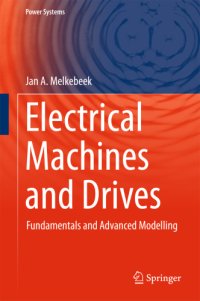
Ebook: Electrical machines and drives: fundamentals and advanced modelling
Author: Melkebeek Jan A
- Tags: Machines électriques--Dynamique, Machines électriques--Modèles mathématiques, Machines électriques -- Dynamique, Machines électriques -- Modèles mathématiques
- Series: Power systems (En ligne)
- Year: 2018
- Publisher: Springer International Publishing
- City: Cham;Switzerland
- Language: English
- epub
Intro; Foreword; Preface; Acknowledgements; Contents; Symbols and Conventions; General; Symbols; Greek symbols; Subscripts; Part I Transformers and Electrical Machines; 1 Transformers; 1.1 Introduction; 1.2 Transformer Equations; 1.2.1 Basic Electromagnetic Description and Equations; 1.2.2 Phasor Equations and Equivalent Circuit for Sinusoidal Supply; 1.3 Referred Values: Equations and Equivalent Circuit; 1.4 Per-Unit Description; 1.5 Construction and Scaling Laws; 1.5.1 Specific Rated Quantities; 1.5.2 Rated Per-Unit Impedances; 1.6 Alternative and Simplified Equivalent Circuits.;1.13 Autotransformer1.14 Phase-Number Transformation; 1.14.1 Three to Six or Twelve Phases; 1.14.2 Three to Two Phases; 1.15 Voltage Regulation Transformers; 1.16 Measurement Transformers; 1.16.1 Current Transformers; 1.16.2 Voltage Transformers; 2 Direct Current Commutator Machines; 2.1 Introduction; 2.2 Construction of the DC Machine; 2.2.1 Basic Construction -- Operating Principle; 2.2.2 Excitation; 2.2.3 Armature; 2.3 Electrical Power Conversion in a DC Machine; 2.3.1 Voltage Induction (emf); 2.3.2 Torque; 2.3.3 Electrical Power Conversion.;3.1.4 Magnetic Field by a Multiphase AC Winding3.1.5 Current Layer -- Linear Current Density; 3.1.6 Discussion and Conclusions; 3.2 Induced Voltage (Electromagnetic Force or emf); 3.2.1 Sinusoidal Rotating Field; 3.2.2 Alternating Field; 3.2.3 Non-sinusoidal Field; 3.3 Magnetising Inductance of an Armature Winding; 3.3.1 Single-Phase Winding; 3.3.2 Multiphase Winding; 3.4 Torque; 3.4.1 General; 3.4.2 Alternating Field and Alternating Current Layer; 3.4.3 Rotating Field and Rotating Current Layer; 4 The Induction Machine; 4.1 Construction.;This book aims to offer a thorough study and reference textbook on electrical machines and drives. The basic idea is to start from the pure electromagnetic principles to derive the equivalent circuits and steady-state equations of the most common electrical machines (in the first parts). Although the book mainly concentrates on rotating field machines, the first two chapters are devoted to transformers and DC commutator machines. The chapter on transformers is included as an introduction to induction and synchronous machines, their electromagnetics and equivalent circuits. Chapters three and four offer an in-depth study of induction and synchronous machines, respectively. Starting from their electromagnetics, steady-state equations and equivalent circuits are derived, from which their basic properties can be deduced. The second part discusses the main power-electronic supplies for electrical drives, for example rectifiers, choppers, cycloconverters and inverters. Much attention is paid to PWM techniques for inverters and the resulting harmonic content in the output waveform. In the third part, electrical drives are discussed, combining the traditional (rotating field and DC commutator) electrical machines treated in the first part and the power electronics of part two. Field orientation of induction and synchronous machines are discussed in detail, as well as direct torque control. In addition, also switched reluctance machines and stepping motors are discussed in the last chapters. Finally, part 4 is devoted to the dynamics of traditional electrical machines. Also for the dynamics of induction and synchronous machine drives, the electromagnetics are used as the starting point to derive the dynamic models. Throughout part 4, much attention is paid to the derivation of analytical models. But, of course, the basic dynamic properties and probable causes of instability of induction and synchronous machine drives are discussed in detail as well, with the derived models for stability in the small as starting point. In addition to the study of the stability in the small, a chapter is devoted to large-scale dynamics as well (e.g. sudden short-circuit of synchronous machines). The textbook is used as the course text for the Bachelor?s and Master?s programme in electrical and mechanical engineering at the Faculty of Engineering and Architecture of Ghent University. Parts 1 and 2 are taught in the basic course?Fundamentals of Electric Drives? in the third bachelor. Part 3 is used for the course?Controlled Electrical Drives? in the first master, while Part 4 is used in the specialised master on electrical energy.;2.4 Armature Reaction and the Compensation Winding2.5 Commutation and the Commutation Poles; 2.6 Steady-State Characteristics; 2.6.1 Introduction -- Per-Unit; 2.6.2 Basic Characteristics and Derivation Methods; 2.6.3 Generator Characteristics; 2.6.4 Motor Characteristics; 3 Rotating Field Machines: mmf, emf and Torque; 3.1 Generation of a Rotating Field; 3.1.1 Magnetic Field by (stator) Salient Poles with Concentrated Windings; 3.1.2 Magnetic Field by Rotating Salient Poles with Concentrated Windings; 3.1.3 Magnetic Field by a Distributed AC Winding.;1.7 No-Load Operation1.8 Short-Circuit Operation; 1.8.1 Short-Circuit Impedance; 1.8.2 Procentual Short-Circuit Voltage; 1.8.3 Remarks; 1.9 Voltage Variation with Load; 1.10 Parallel Operation of Transformers; 1.11 Construction of Single-Phase and Three-Phase Transformers; 1.11.1 Single-Phase Transformers; 1.11.2 Three-Phase Transformers; 1.12 Connection and Vector Group of a Three-Phase Transformer; 1.12.1 Winding and Terminal Markings; 1.12.2 Modelling of a Three-Phase Transformer; 1.12.3 Connections and Vector Groups; 1.12.4 Asymmetrical Operation of 3-Phase Transformers.
Download the book Electrical machines and drives: fundamentals and advanced modelling for free or read online
Continue reading on any device:

Last viewed books
Related books
{related-news}
Comments (0)